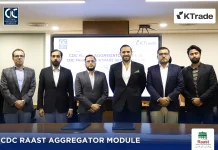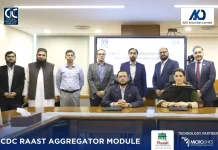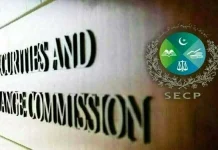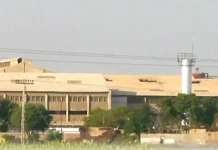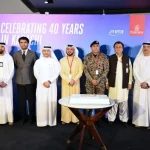The government is fine tuning its recommendations on structural reforms in petroleum sector aimed at pulling it out of financial distress through several measures including renegotiation of LNG contracts, settlement of massive gas sector circular debt, reduction in exorbitant port charges, consumption of surplus RLNG and improvement in domestic gas tariff efficiency.
Sharing the details, the sources said, the 5th meeting of the Committee on implementation of structural reforms in petroleum sector was held on August 18, 2025 under the chairmanship of Minister for Petroleum Division at Task Force Head Quarters, Army Air Defence HQ Westridge, Rawalpindi.
The meeting was attended by Advisor to PM on Privatisation, Lt. General Zafar Iqbal, Secretary Power, Additional Secretary, Petroleum Division and Chairman OGRA. Secretary Petroleum did not attend the meeting because of meeting of Senate Standing Committee being held at the same time.
Circular debt: Pakistan govt moves to cut LNG import, reform gas sector
Petroleum Minister shared a brief update on the progress made in the previous four meetings and emphasized the need to finalize the report of all sub-committees for submission to the Prime Minister.
Sub-Committee on LNG: Power Division presented an in-depth comparison of the Energy Purchase Price (EPP) between imported coal and RLNG. Assumption sets including solar adoption were adopted on the basis of which the values have been worked out.
Demand growth forecast was kept at 2.8 percent Gen Zafar highlighted that national-level losses could be significantly reduced by substituting imported coal with RLNG (at reduced cost given its higher efficiency).
Naveed Qaiser from PPMC presented data indicating that at current pricing, the power sector consumes up to 340 mmcfd of RLNG which will be reduced to 175 mmcfd by 2031. As per data, there is potential to consume an additional 174 mmcfd at Rs 1,500/mmbtu and 127 mmcfd at Rs 2,000/mmbtu. It was also noted that additional consumption of only 95 mmcfd can be achieved at a price point of Rs 2,209 mmbtu.
He mentioned that analysis of NPD was also conducted wherein it was assumed that if gas is provided at Rs 1,500 mmbtu to the power sector then the impact of $ 305 million would have to be absorbed (which will be reduced under other two price scenarios of Rs.2000 mmbtu and 2209 mmbtu).
On the other hand, if the Qatar cargoes are dealt under NPD, its implication will be $ 24 million at present prices. The Minister observed that NPD loss would be a moving number which cannot be locked.
The representative of Task Force commented that the reduced price will have the advantage of enhanced LNG usage and other benefits in terms of availability of electricity in Punjab rather than transmitting it from South with additional losses up country.
He explained that even if Pakistan opts to walk away under Qatar contract-1, it will still be obligated to get at least four cargoes from Qatar under contract-2 which are committed for the next five years.
Its implication is that 360 mmcfd has to be used to keep the sector sustainable. It was responded by the Power Division that the marginal cost may be changed by reducing the price and its not a recommendation for conversion.
He added that there are two options, one is that the rate of gas may be reduced so that power plants come up on the merit order and the other option is that cargoes may be sold under NPD. The current analysis depicts that spot prices are high so the loss will be smaller than diversion.
Further discussion focused on identifying an optimal price point for LNG that would result in minimal loss to the national exchequer, ensure foreign exchange optimization, and strike a balance between affordability and revenue neutrality.
Minister Petroleum summed up the discussion by stating that the Power Division maintains that it needs to be explored whether the country would be better off by providing gas to power sector at reduced rate or by not taking surplus volumes and allowing them to be sold under NPD. Joint recommendation to be submitted by the Power Division, Petroleum Division.
The representative of Task Force commented that there are elements to be added in the presentation of the Power Division to sharpen the price point where revenue requirement becomes zero (the price where power sector consumption would improve through replacement of imported coal) and what’s most beneficial for Pakistan as coal offsets will reduce coal imports thus saving foreign exchange.
Minister Petroleum stressed he values the Qatar relationship and Qataris have supported Pakistan; also price-opener should not be construed as volume opener.
A panel, comprising Brig. Khalid, Naveed, Additional Secretary Petroleum Division, Additional Secretary Power Division, Asad Hussain from Privatisation and Misbah of OGRA has finalized recommendations on the price point for power sector and the LNG pricing model that entails zero revenue requirement, aligns with minimum loss projections with comparative benefits of price reduction versus NPD conversion for Pakistan.
Sub-Committee on Circular Debt Mitigation: Asad Hussain presented the working on gas sector circular debt settlement plan.
The presentation highlighted that total receivables of SUIs stand at Rs 2.029 trillion out of which Rs 1394 billion is the tariff differential cost (natural gas and LNG). It was highlighted that receivables of OGDC, PPL, GHPL and PSO stood at Rs 1.644 trillion. But for the purposes of proposed settlement an agreed number of Rs 1.394 trillion is being used.
After highlighting the cardinal assumptions, the working, the plan was presented with focus on five key revenue streams for cash inflow to address gas sector Circular Debt (CD).
These streams included (i) savings from reduction of excess LNG cargoes beyond those needed to reduce tariff (as recommended by sub-committee 1), (ii) possible imposition of Rs. 5/litre petroleum levy (iii) utilization of incremental dividends from SOEs (particularly E&P companies), (iv) recovery of RLNG receivables from the power sector, and (v) a minor component of take or pay liability under LCIA decision.
Under the plan Rs 305 billion were assumed as saving from reduction of LNG, Rs 450 billion were assumed from imposition of PL and Rs 589 billion were assumed from incremental dividend by OGDC, PPL and GHPL.
The plan proposed a centralized pool of all collections from available streams to be ringfenced for dedicated use to settle the CD only. SAPM and representatives of Task Force commented that for the time the government should assume full waiver of LPS/interest payable to gas producers.
On cash inflow side, the plan indicated that after all the agreed actions in next five years the four SOEs namely OGDC, PPL, GHPL and PSO will get Rs 459 billion, Rs 490 billion, Rs 182 billion and Rs 263 billion respectively. At this point discussion focused on allocation of Rs 218 billion to PPL from dividend pool against Rs 189 billion for OGDC.
As a result, there was leakage of Rs 53 billion in PPL as payment to non-controlling interests against a leakage of Rs 28 billion in OGDC. It was proposed that the positions of OGDC and PPL be interchanged to decrease leakage which was primarily being backstopped by GHPL.
It was proposed, and endorsed by the Minister, that all such inflows-especially the petroleum levy-should be ringfenced exclusively for CD settlement to ensure financial discipline and transparency. It was further agreed that exemptions from SECP be sought to safeguard SOEs against the impact of various IFRS obligations and that Ministry of Finance will be taken on board by Task Force before presenting the plan to Prime Minister.
With minor adjustments, the Sub-Committee agreed in principle with the proposed plan and the team working on this was tasked to incorporate changes and suggest operating mechanism for further discussions with Ministry of Finance.
Sub-Committee -3: LNG Tariff Rationalization: The Additional Secretary Petroleum Division briefed the Committee that the sub-committee had two ToRs; LNG tariff rationalization by visiting all add-ons and demand maximization specially in the domestic sector on full cost recovery. On the TOR-2 of the Committee, it was informed that a summary has been submitted for relaxation in moratorium on new RLNG connections.
On ToR-1, it was informed that there are around eleven add-ons which constitute around 40% of the cost. Two main components relate to PQA, four measures were related with taxation and rest were related to SUIs and LNG importers.
Minister for Petroleum drew attention of OGRA to the add-ons with directions to validate the information. Minister asked the Petroleum Division to quantify as to how many $/mmbtu these add-ons constitute of the total cost. It was informed by OGRA that there are around $ 3 which impact prices competitiveness.
The Committee reviewed all taxation issues and in view of the ongoing IMF programme agreed not to propose any actions at this stage. Further as Sindh Infrastructure Cess issue is in Court of Law, Minister for Petroleum stressed the need to expedite legal proceedings and allow the Court to determine the fate of Sindh Infrastructure Cess. Gen Zafar suggested Thar coal matter be also assessed and asked Petroleum Division as to how these issues can be linked to get some reasonable outcome.
Petroleum Division highlighted the PQA has been charging $ 100,000 per cargo as Channel Development Cess and till 2021 an amount of $ 46 million has been collected. In pursuance of the Committee’s deliberations, PSO has written to PQA for refund of this amount. It was informed that refund is unlikely to materialize but the accumulated unutilized amount can be adjusted in future Port Charges. After 2021 these charges are not being levied.
On the issue of port charges, it was informed that PQA is charging $ 550,000 per cargo which includes a pilotage fee of $ 312,000 which seems high. If Petroleum Division calculates same as per PQA own notification, for a 100,000 ton ship this should be $ 24,000 as being charged to other cargo ships. This significant discrepancy was flagged as a key contributor to LNG cost inefficiencies.
The Committee inquired about the international practice if other ports are also charging higher rates to dangerous cargoes like LNG.
Asad Hussain searched the rates of various ports and shared the data which revealed that most ports are using two-tier system and charging higher rates for LNG cargoes but the rates charged by PQA were still higher as compared to UAE and Bangladesh and there is lot of room for downward adjustment.
Representative of Task Force commented that there is also need to hold the person responsible who agreed to such high rates at the time of signing of agreements.
On returns to SUI companies, it was informed that they are being paid a negligible amount of $ 0.025/mmbtu to cover various costs like those for LNG pipelines and SBLC. So there is not much room for adjustment.
On the issue of margins to PSO and PLL being paid @2.5% of ex-ship price it was appraised that these can be adjusted downwards provided PSO gets relief in the under-discussion CD settlement plan. Hence these be left frozen for now.
The Committee was updated that an additional cost component of $ 0.57/mmbtu has been accruing because of supply of subsidized LNG to two fertilizer plants. The committee noted that once the issue of surplus LNG is handled this component will automatically be eliminated.
The Committee decided that PQA authorities be invited to the Task Force for discussions to rationalize excessive port charges in line with international best practices and regional benchmarks. The Committee was tasked to review the process for signing the Agreement at such rates and to fix responsibility if any.
Sub-Committee-4; Domestic Gas Tariff Efficiency: Chairman OGRA, Masroor Khan stated that as per decision of the Committee during the last meeting, OGRA has compiled a report on the prevailing tariff methodology, particularly the Return on Asset (RoA) model. With regard to RoA, OGRA has issued a Letter of Intent (LoI) to KPMG for undertaking the study. Chairman OGRA also informed that a UFG study exercise would be started immediately and completed well in-time (Nov.2025).
Minister for Petroleum asked KPMG about their plan on the RoA study and what possible alternative they have in mind. Minister stressed that essentially the treatment will be around unbundling the transmission and distribution side of the business from fuel business.
KPMG informed that they will be looking at various models being used worldwide to suggest a way forward on alternatives to the ROA framework. Extensive Sui distribution network must be kept in mind while looking for benchmarking options.
After deliberations, the Committee decided that OGRA would explore alternative models to RoA, with the objective of enhancing efficiency, ensuring transparency, and introducing competition within natural monopolies to promote fair pricing mechanisms for consumer protections.
Wrapping up the meeting the Minister for Petroleum Division, Ali Pervaiz Malik emphasized the need to finalize all outstanding items-particularly pricing issues-at the earliest so that a comprehensive report can be submitted to the Prime Minister’s Office without delay. Sub-committees to present their final reports to Cabinet Division by August 25, 2025 (today) and the Cabinet Division to share draft report with the Convener/Co-Convener by August 30, 2025.






